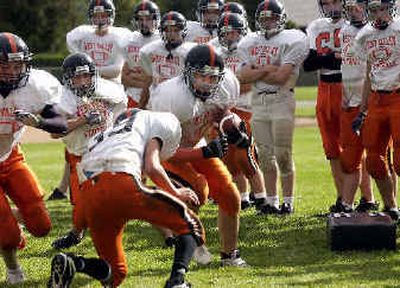Matter of class size

In real estate the three biggest considerations are location, location and location.
When it comes to the Washington Interscholastic Activities Association, the consideration shifts to class size, class size and class size.
Last spring, the WIAA representative assembly passed a new classification plan scheduled to begin in the fall of 2006. It calls for the smallest 28 percent of the schools to be classified as B with the remaining schools divided evenly into four classifications — 18 percent each.
At West Valley, the smallest Class 3A high school in the Greater Spokane League, a close eye always is kept on enrollment figures, and there was a point where the school might have to consider dropping out of the GSL and entering the Class 2A Great Northern League.
Those declining numbers, however, have turned into an upward trend in the district, the school’s athletic coordinator, Wayne McKnight said.
“There would have to be a pretty drastic change to affect us,” he said. “I’m not anticipating any changes. I just don’t see us shifting. We’re getting too many kids through these doors, and to shift to a completely different classification, I just don’t see it.”
However, the state’s athletic landscape is currently being resurveyed. McKnight is active among the state’s athletic directors and is attended a state athletic director’s meeting Sunday.
The news coming out of that meeting is that the future is still cloudy when it comes to the concept of improving the system. Several amendments to the new classification system are being floated for his spring’s meeting.
The proposals being considered include adding a sixth classification, Class 5A, for football.
“There are options. There could be amendments to options,” McKnight said. “And there could be some alternatives no one has yet seen.”
If the state were to opt for a radical of change, adding a Class 5A for football only, West Valley could become even more solidly entrenched in 3A.
“What that would do, and I’m just using a rough description, is take the true Class 4A-sized schools and split them, with the top two-thirds going one direction, with the bottom third and the Class 3As hooking up,” McKnight said. “You’d have a top group of schools with around 2,000 kids in it, then the next group would drop down to about the 1,200 to 1,600 or 1,800 range, and the Class 3As would drop in between, maybe about 800 and 1,200. That’s pretty radical, but it’s out there. Just for football. But nobody knows for sure.”
One of the primary sticking points in the process is the status of Class B schools. Creating classifications by a straight percentage, as scheduled for fall 2006, would move some of the larger Class B schools up to Class 1A—a situation some small schools want to avoid.
Because so few schools offer all sports, Class B leagues tend to shift from sport to sport. Football, for example, is divided into eight-man and 11-man divisions, with a number of schools, like Valley Christian School, which do not offer the sport at all.
“That’s the magical one,” McKnight said. “One of the pushes, and where some of the blocks will come, will be to just leave the Class Bs, the Class 1As and the Class 2As alone — just leave them alone, and divide the Class 3As and the Class 4As up whichever way you think is best.
“That doesn’t help the Class 3As at all. There are schools like ourselves, who are right at the bottom of the Class 3As, and if we can’t move, then there’s nobody left to move to. We need to have the top end of those Class 2As move up with the bottom of the Class 3As to balance it out in terms of numbers of schools.”
The politics that come into play when the state deals with such large-scale problems can be wearing.
“You try to reconfigure the whole state, and the whole state doesn’t come together — that starts to grind on me,” McKnight said. “You can’t do everything in an idealistic fashion. But the other side of that coin is that we can do better than what we’ve got. We have to do better for the kids of this state. And I don’t care where we end up, but that’s my opinion. We can do a better job for our kids.”